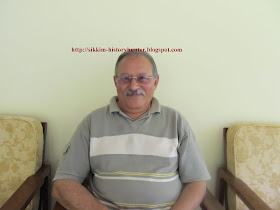 |
| Turuk Kothi standing with the same pride since ages. |
 |
| Mr. Hridayendra Pradhan 7th descendant of Lacchmi Das Pradhan . |
The Newars have played an imperative role to strengthen the Sikkimese economy during the 19th and 20th century. It is a knowing fact that, after receiving permission from the Sikkimpati Maharaja they started to mint coins in the name of the Sikkimese rulers. Those coins were known as Dheba Paisa and Cheptey Paisa. The picture in today’s post also belongs to the same Newars who are credited for the creation of the Sikkimese coins.It may be mentioned here that the coins of Nepal were in circulation in Tibet and Bhutan before the rise of the Gurkhas in 1768. We do not however, know whether these coins were also in circulation in those days. But, the practice of receiving the Tibetan or Indian coins had never been objected to by the rulers of Sikkim; rather they used to accept revenues in these coins from the people residing in the border areas. (Aspect of Cultural History of Sikkim- Studies in Coinage, Pranab Kumar Bhattacharyya P.25)
Leaving aside the doubtful meanings of the terms Srang and Zho mentioned in the Old Sikkimese Law Book, the minting of the coins of Sikkim seems to have been started by the Newar tradesmen headed by Lacchmi Das Pradhan who were originally given contract for extacting copper from the mines. They were all known as Taksari meaning ‘owner of minting houses’. (ibidP.35)
 |
| Rorathang Copper Mine from where the Taksaris extracted Copper to mint Coins |
Situated 17 Kms away from the South District Head Quarter Namchi the Turuk Kothi has many unique features. The most important among them is that it belongs to the first minter of Sikkim Lacchmi Das Pradhan. This edifice was constructed by him probably after receiving a Land Patta to extract copper from different parts of Sikkim. The historical records of Sikkim provide information that the first Patta to the Nepalese was issued in 1868. Therefore, it is obvious that the Kothi was constructed after receiving the royal order to get a Patta in the name of Lacchmi Das Newar. In this sense, this edifice can be regarded as the oldest construction of Sikkim constructed for the residential purpose. Further, Lacchmi Das was also responsible for bringing the Nepali settlers from Nepal to Sikkim to cultivate the unproductive and barren lands of Sikkim.
Another historical importance of this house is that it had served as a District Head Quarter for many years. The earlier Taksaries later became the Rai Sahibs and served the Sikkimese monarchs as their subordinates. During a brief talk, Hridayendra Pradhan, a 7th descendent of Lachhmi Das Pradhan told me that the edifice also used to have a Settlement House then known as Kuccheri to settle the disputes among the subjects residing in their Estate. Further, the house also had a prison to punish the culprits. But, unfortunately due to the lack of maintenance the Settlement House and Kuccheri were demolished few years back.
The most amazing aspect of the Kothi is that even after the lapse of nearly 142 years, the descendents of Lacchmi Das Pradhan are living in the same house which was constructed by their dynamic ancestor. The present resident of the Kothi, Mr. Hridayendra Pradhan informed me that all the Sikkimese coins which were circulated during the 19th century were minted at the very same spot. For the minting of such coins they used to extract copper from Pacheykhani in East Sikkim and were brought to Turuk to accomplish the task of minting. On the obverse of Doley Paisa (a denomination of Rupee also known as Dheba Paisa or sometimes Dooba Paisa) they struck Shri Shri Shri Sikkim Sarkar in Nepali to give a distinct outlook from the Nepali coins.
But the coinage of Sikkim had a short life as it was unable to circulate itself in the Gurkha dominion of Nepal due the hurdles imposed on Sikkimese coins by them. To remove such restrictions the Newar traders of Sikkim made their representation to the Prime Minister of Nepal. But, all their efforts went futile as the Nepalese authorities rejected the petition of Newari traders on the ground that “The present pice (Paisa) coin of Sikkim issued to be lesser in weight then that of Nepal.”(ibid pp28-29)
The decision of the Nepali Government proved akin to a last nail on the coffin to the Sikkimese coinage. Though, the dream of the Newari traders to mint a distinct coin for Sikkim had an untimed demise, they occupied reputed chairs under Sikkimese monarchy to execute their services to the Sikkimese Crown and its Subjects.
On the obverse of Doley Paisa (a denomination of Rupee also known as Dheba Paisa or sometimes Dooba Paisa) they struck Shri Shri Shri Sikkim Sarkar in Nepali to give a distinct outlook from the Nepali coins.
ReplyDeleteThe above statment is not correct. Dheba or Dooba paisas were rectangular pieces of copper weighing about 10 g and had no inscription.
The coins which you describe above (with the inscription "Shri Shri Shri Sikim Sarkar" on one side) are called chepte paisas and had less than half the weight of the Dheba paisas.